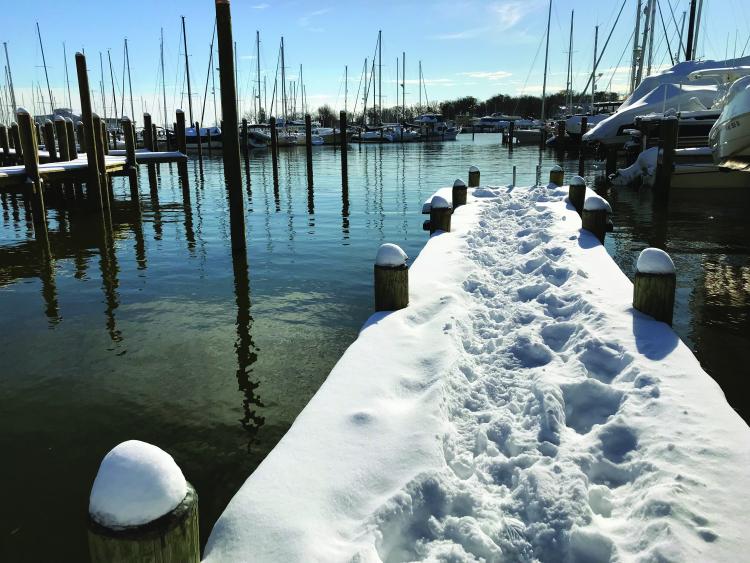When the docks are snowy, frosty, icy, or slippery
A little bit of snow transforms the Bay’s shoreline into a beautiful winter wonderland, but slippery docks and boat decks poised above frigid water are serious business. These four commonsense precautions go a long way to keeping safe.

Four great tips for walking the docks and decks
- “The most important thing is quite simple—be mindful of every step,” says Cindy Fletcher-Holden, a longtime liveaboard who has endured many winters on the water and for whom the importance of safety has hit too close to home on more than one occasion when a friend has fallen into cold water. Cindy says, “Normal muscle memory is not enough to rely on when transiting snowy, icy, or even frosty docks, and especially not when stepping on or off a boat. It sounds simple, but small things, such as dressing warmly, make a difference because you’re less likely to rush and can think properly.”
- Secondly, Fletcher-Holden recommends holding onto something. “It gets back to basic seamanship,” she says, “one hand for the boat.” Off the boat, get creative. Many sailors, including Fletcher-Holden and liveaboard Caroline Foster, run a line from piling to piling along their finger piers, and slide one hand along. Fletcher-Holden says, “We place a metal statue of a penguin on the dock as a visual reminder.”
- Third, proper footwear can make all the difference. Tempted to wear those warm but clunky snow boots? They might make it tough to really feel the surface beneath you. Athletic shoes with a strap-on traction device with spikes on the bottom have been a game-changer for Fletcher-Holden. If you’re worried that spikes will hurt the deck paint, she suggests that before the bad weather hits duct tape a cheap piece of carpet or another type of mat wherever you will walk.
- Finally, when it comes to clearing docks and decks, salt and shoveling are your go-to methods. Of course, not everyone wants salt on their boat deck, so to each his own. Foster says they are careful to keep scuppers and the flybridge cleared of snow and ice. A broom will work wonders for a light dusting or a very cold, dry snow; but when it’s wet, heavy, and piled high, it’s shovel time. Using a light-weight model, create a path down the center of the pier. Leaving ridges on the edges will provide a visual boundary wall. Let’s face it, shovels can easily get stuck between the boards, so try taking small scoops at an angle. Once you’re down to wood, apply salt. If you can’t get it totally clear or don’t intend to apply salt, sometimes crunchy footprints end up providing more traction than a nearly cleared path that reveals a thin layer of the slippery stuff. Finally, Foster suggests the buddy system. “When possible, bring a friend when you clear snow and ice off the boat. Otherwise, let a friend or neighbor know where you are going.”
SpinSheet readers, be warm, be safe, and send us your pretty winter boating and shoreline photos.




